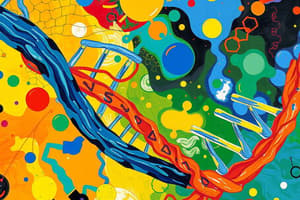Podcast
Questions and Answers
What is Acyclovir?
What is Acyclovir?
Inhibitor molecule that targets viral DNA polymerases.
What is semiconservative DNA replication?
What is semiconservative DNA replication?
During replication, each daughter duplex consists of one parental strand and one newly synthesized strand.
What is the origin of replication?
What is the origin of replication?
Unique sites where replication begins and replication forks move bidirectionally.
In what direction does DNA synthesis occur?
In what direction does DNA synthesis occur?
What are the rules of DNA replication? (Select all that apply)
What are the rules of DNA replication? (Select all that apply)
What is AAA+ ATPase?
What is AAA+ ATPase?
What is the function of DNA ligase?
What is the function of DNA ligase?
What is the role of DNA polymerase?
What is the role of DNA polymerase?
What is helicase?
What is helicase?
What do endonucleases and exonucleases do?
What do endonucleases and exonucleases do?
What is the function of primase?
What is the function of primase?
What is the function of topoisomerase?
What is the function of topoisomerase?
What occurs during the initiation of DNA replication?
What occurs during the initiation of DNA replication?
Describe the elongation process of DNA replication.
Describe the elongation process of DNA replication.
What are topoisomerase II-directed agents?
What are topoisomerase II-directed agents?
What are topoisomerase II poisons?
What are topoisomerase II poisons?
What are catalytic inhibitors?
What are catalytic inhibitors?
Flashcards are hidden until you start studying
Study Notes
Acyclovir
- Inhibitor that targets viral DNA polymerases.
- Phosphorylated by a viral-encoded thymidine kinase, ensuring effectivity mainly in infected cells.
- Chemical structure resembles guanine with an incomplete ribose lacking a 3' OH group, acting as a chain terminator.
Semiconservative DNA Replication
- During replication, parental DNA strands separate and serve as templates for new strands.
- Each daughter duplex contains one original strand and one new strand.
Origin of Replication
- Unique sites initiate DNA replication where replication forks move bidirectionally forming a replication bubble.
- Rich in AT base pairs, allowing easier unwinding due to only 2 hydrogen bonds.
Direction of DNA Synthesis
- DNA synthesis occurs in the 5' to 3' direction.
- Deoxynucleotides are added to the 3' end of a growing chain, beginning with an RNA primer.
Rules of DNA Replication
- Replication is deemed conservative.
- Initiation occurs at an origin and proceeds bidirectionally.
- Synthesis is continuous in the leading strand and discontinuous in the lagging strand.
AAA+ ATPase
- DnaA protein binds to replication origin and disassociates helical strands.
- ATP binding induces a conformational change in DnaA, promoting strand separation.
DNA Ligase
- Seals nicks in DNA by forming phosphodiester bonds, requiring ATP for the process.
DNA Polymerase
- Enzymes that facilitate the elongation of the DNA strand.
- Require a single-stranded DNA template and an RNA primer to function.
Helicase
- Enzyme responsible for unwinding the DNA double helix.
- Utilizes ATP to break hydrogen bonds between base pairs.
Endonuclease and Exonuclease
- Enzymes that sever phosphodiester bonds in the DNA backbone, facilitating repair and processing.
Primase
- Synthesizes short strands of complementary DNA as primers for DNA polymerase.
Topoisomerase
- Enzymes that relieve supercoiling in DNA, operate by cleaving strands and rejoining them.
- Type I cleaves one strand, while Type II cleaves both strands for supercoiling adjustments.
DNA Replication: Initiation
- DnaA binds to the origin, creating a replication bubble and recruiting essential factors.
- Helicase unwinds the double helix using ATP to break hydrogen bonds.
- Single-stranded DNA binding proteins maintain unwound DNA.
DNA Replication: Elongation
- Primase synthesizes short RNA primers for DNA polymerase III initiation.
- DNA polymerase III extends the leading strand continuously and synthesizes the lagging strand as Okazaki fragments.
- DNA gyrase (Type II topoisomerase) introduces negative supercoiling to relieve torsional stress.
- DNA polymerase I replaces RNA primers with DNA and fills gaps between Okazaki fragments.
- DNA ligase seals nicks, converting fragmented DNA into a continuous strand.
DNA Drugs: Topoisomerase II-directed Agents
- Interfere with steps in the topoisomerase II catalytic cycle.
DNA Drugs: Topoisomerase II Poisons
- Stabilize covalent complexes with DNA topoisomerase II, often used for anti-tumor therapies.
DNA Drugs: Catalytic Inhibitors
- Agents affecting various steps in the topoisomerase catalytic process, serving as antineoplastic, cardioprotective agents, or enhancing other drug efficacy.
Studying That Suits You
Use AI to generate personalized quizzes and flashcards to suit your learning preferences.




